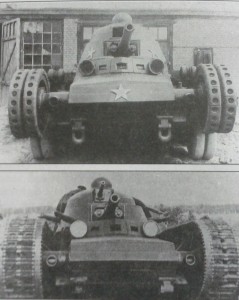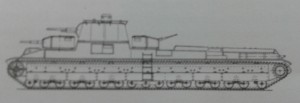In the late 1920s, the USSR discovered that they were kind of screwed as far as tank building went. The MS-1 tank was no longer capable of meeting the requirements of modern war, not to mention the aged tanks captured during the Russian Civil War from the interventionist forces.
The way taken out of the situation was very reasonable: hire foreign specialists, have them build tanks at Soviet factories, let Soviet engineers and workers gather valuable experience. Unfortunately, the foreign specialists gathered for the task were not so reasonable. One of these specialists was Edward Grotte. Grotte worked for the USSR for less than two years (March of 1930 – fall of 1931). However, he managed to produce a number of interesting ideas in the meantime.
In March of 1931, Grotte proposed two variants of a monstrous tank. 1000 tons, with either 3 or 6 turrets, armed with 304 mm, 152 mm, 76 mm, and 45 mm cannons (two of each!). 40 people serviced this mobile fortress. Front armour was 300 mm thick, the sides were 250 mm. The tank would be propelled to 60 kph by an assembly of engines totaling 24 000 hp. The tank would have electric controls and a hydromechanical transmission. If you thought that the T95′s double tracks were impressive, think again. Grotte’s creation had three sets.

Grotte’s sketch of his 1000 ton tank project
Grotte’s main creation was much more reasonable: Tank Grotte, a medium breakthrough tank, was only 25 tons in mass, was armed with a 76.2 mm Grotte-Sechyantov gun and a 37 mm gun in a turret above it, kind of like the M3 Lee. Also much like the Lee, the main gun could not rotate all the way around. It was limited to aiming 10 degrees each way, with -8 degrees of gun depression. The 37 mm PS-1 gun in the turret could depress to an impressive -12 degrees. The tank also had five machine guns. The much more realistic 250 hp engine provided a maximum speed of 35 kph. An interesting feature of the tank was emergency brakes, meant to stop the tank as quickly as possible in the event of a damaged track. One of these tanks was built and tested, but proved too complicated and unreliable to mass produce.

TG medium breakthrough tank: with tracks removed (top) and on (bottom).
In March of 1932, Grotte was back to heavy tanks. The TG-VI 3 was only 70-75 tons, a far cry from his kiloton monster. Armour of the tank was between 60 and 70 mm, and it was armed with two 45 mm guns and one 76 mm semi-auto gun or 100 mm gun. An 850 hp engine would push the tank to a reasonable 30 kph. This tank did not go very far, but far enough to serve as a base for the T-42 project. This tank was more optimistic, at 100 tons, with a 2000 hp engine for its rated 30 kph speed (or only 18 kph, if he only had the 850 hp M-34 engine). The T-42 had a 107 mm gun in its central turret (270 degree traverse), a 76 mm gun in the front turret (202 degree traverse), and a 45 mm gun in the rear turret (278 degree traverse). Since no bridge could hold this tank, it could be automatically brought into water-tight condition and ford a water hazard of up to 2 meters deep.

T-42 tank
Grotte’s last contribution to the world of armoured warfare was the 1000 ton Ratte tank, cancelled by Speer in 1943.

It seems we have left out how he got to be working for the Germans… Seems we will be waiting for a part 2.
Nice article so far.
NEMO.
More on Mr. Grotte and his tanks.
http://forum.worldoftanks.com/index.php?/topic/72953-tank-grotte-tg-tank-t-22-tank/
Looks like the Russians had their own Ratte’s.
Oh, there were pretty of giant Soviet tanks planned, but they calmed down on the subject before WWII started. Maybe I should do an article on a few of those :)
That would be totally cool, Ensign, I’m hoping to read such an article soon! (if you’re interested in writing it, ofc xd)
Ironically it was designed by german engineer.
1000 tons
24000 horse power
300 mm frontal armor
60 km/h top speed
who needs guns on this monster, it could simply ramming anything it meets
And you are posting same thing twice for what reason exactly?
Old FTR website, Ensign’s Q&A 3….
I briefly mentioned the 1000 ton tank, the TG, and T-42 before, but nothing that was equivalent to a full article.
Any you are whining why exactly ? If you don’t like the article, then skip it.
*And* you are whining why exactly ? If you don’t like the comment, then skip it.
I would like to see Ratte vs Grotte Ubertanks in battle :D
P1500 will one-shot them :D
LOL if this got in the game it would be lighter than the TOG II*
The T-42 would actually be balanced with the TOG II*, wouldn’t mind it being a tier 5/6 premium.
Yes they both (TG-VI 3 and T-42) seem that they would be pretty balanced in game, the T-42′s 107 mm might be a bit too derpy though.
Not really
The T-150 has 107 mm ZiS-6 ingame
But tier 6?
I didnt see any armor values there so thats a question.
I’m still waiting for my FCM F1, I’ll her with my TOG and make my personal Franco-British Commonwealth of oversized tanks!
…and here we have an illustration of one of the implicit hazards of hiring foreign experts – you may just get the nutters whose talents were going unused back home for good reasons. :D
Bullshit alarm on FTR again.
First, 1000ton tank was never proposed by Grotte – neither a Soviet, nor a German one. It comes from Russian schoolpeople not being able to hold apart Grotte and Ratte.
Second, TG-1 was never called “medium breakthrough tank”, the designation was “maneuverable medium tank”
Third and most important, the main 76mm gun was meant to be placed in a fully rotational turret, but unfortunately, but the soviet engineers were unable to build it that way, so the TURRET was WELDED onto the hull. The gun is FIXED and has NO horizontal rotation, since the gun mount was designed for a turret.
P.S. Is Grotte actually the correct spelling anyway? I have never seen an article in English language, not being based on Russian-language book, and in Russian the name usually spells with one “T”, thus making 3 spelling possible: Grote, Grotte (sometimes double letters are dropped) and Grothe (since an “h” in such a function is absent in Russian, it is always dropped).
I tend to believe the last is correct, since this surname is actually common in Germany.